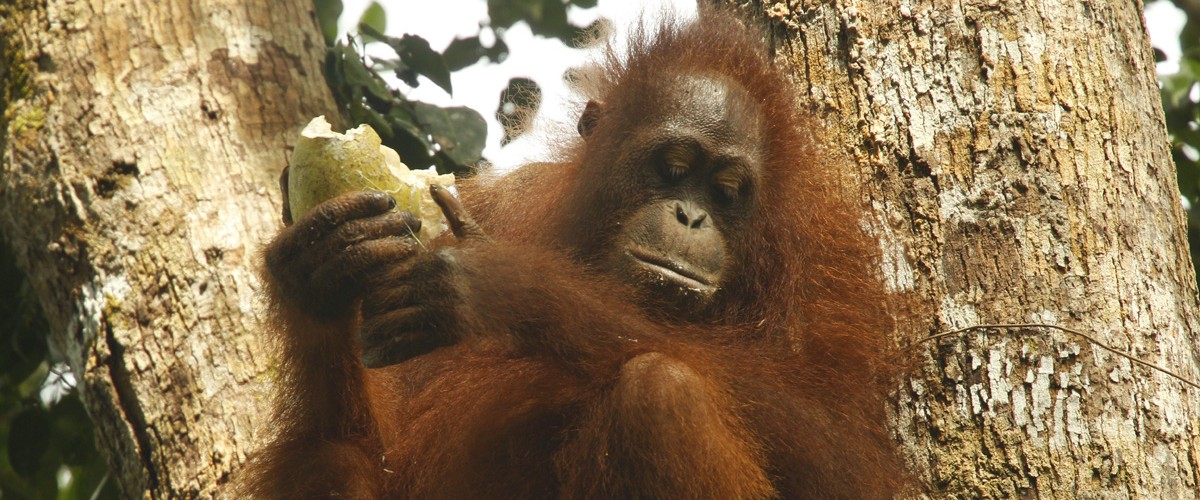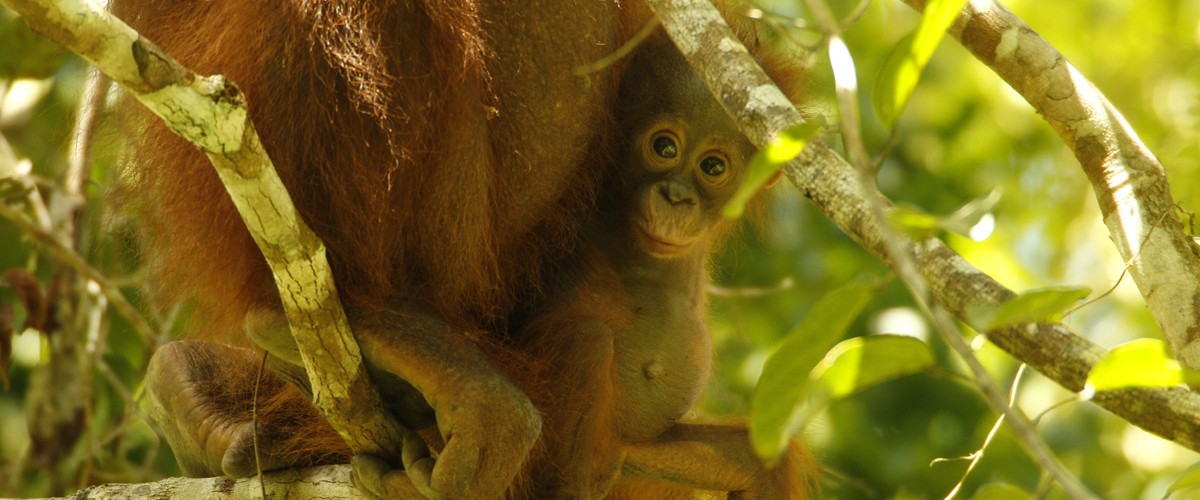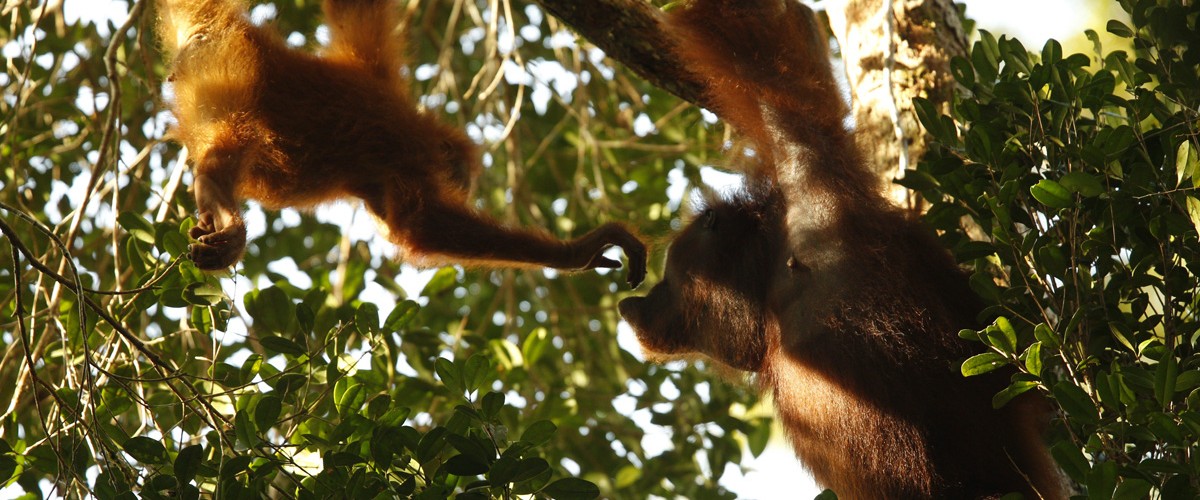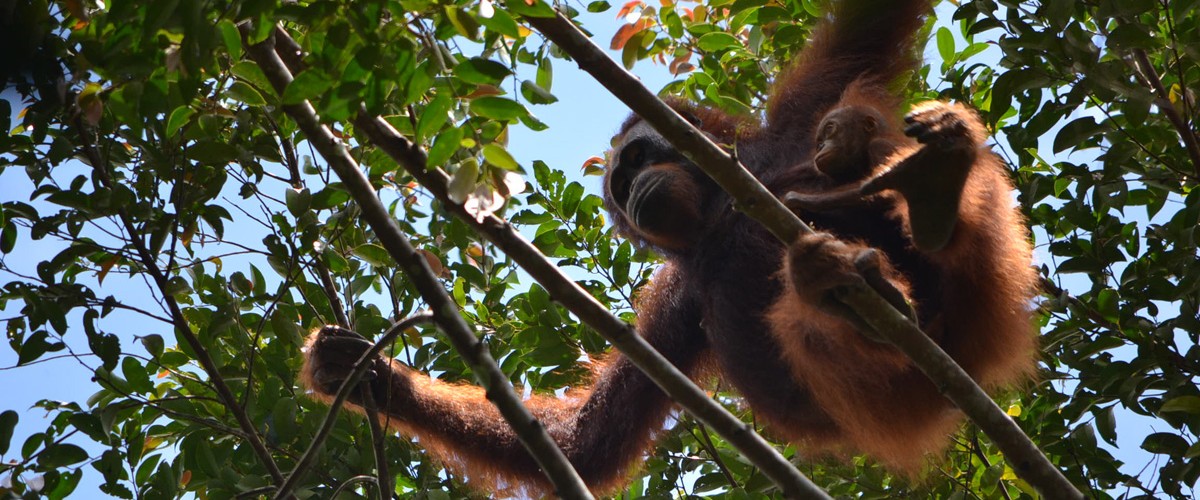By Cheryl Knott, Executive Director
As a child growing up in the 1960s, I remember being enraptured by the grandfatherly Louis Leakey describing his discoveries of human fossil ancestors in National Geographic TV specials. This ignited a lifelong interest in trying to understand where we came from, how we got here and why we are the way we are that has remained at the core of my intellectual journey. Louis Leakey recognized that the study of living apes provides another window into the human evolutionary past and supported some of the earliest great ape research. Much of our research on wild orangutans is tied to developing a deep understanding of one of the few remaining ape species to help inform our understanding of human evolution and what led us down the path that distinguishes us from the other living apes. As I became a biological anthropologist and set out to study wild orangutans, I reached out to the Leakey Foundation, founded in 1968 to help support Leakey’s research, and was awarded one of the core grants that allowed me to start the Gunung Palung Orangutan Project. Since then, our project has been awarded 11 grants by the Foundation.  Executive Director, Cheryl Knott (left) examines fossil skulls during a 6th grade visit to the San Diego Museum of Man. Photo by Eldona Lay. It was thus with much gratitude that this summer we were honored to host members of the Leakey Foundation and associates on a special trip to Gunung Palung National Park. Joining us were Jeanne Newman, President of the Foundation, Trustee Chester Kamin, Professor Richard Wrangham, Timothy Bradley, Michael Brower, and Sally Cheffy. This was a very special trip and we are grateful to the Gunung Palung National Park authorities for making this possible. It took several months of preparation by our staff to make a visit to our remote research camp a reality and here is the story of that journey. The group flew into our small airport in Ketapang, West Kalimantan, Indonesia, on August 12. After a delicious late lunch we stopped by the Yayasan Palung office where trip members got to see our conservation project headquarters. There they had a full overview of how we store the plant, fecal and urine samples that we collect at the research station before they make their way to one of the laboratories we use for analysis. An unexpected surprise at the office was the arrival of durians that, lucky for us, were in season. The group was game to try, most for the first time, this much-loved, but pungent, fruit. |
 |
 Group members try durian fruit at the Yayasan Palung/GPOCP office with Research Director, Wahyu Susanto (top), and visit the Research Room (bottom). Group members try durian fruit at the Yayasan Palung/GPOCP office with Research Director, Wahyu Susanto (top), and visit the Research Room (bottom).That evening we all enjoyed a welcome banquet at the Hotel Grand Zuri that started off with traditional Dayak and Melayu dancing performed by members of our youth conservation group. I gave an overview of the work of the Gunung Palung Orangutan Conservation Program and we watched videos during dinner about each of GPOCP’s programs. Attendees included our staff as well as representatives from the Gunung Palung National Park office who co-hosted the visit. Ibrahim Sumardi welcomed the guests on behalf of the National Park, and Jeanne Newman and Richard Wrangham shared some words. |
  Dancers from our youth conservation group performed traditional Melayu (top) and Dayak (bottom) dances at the welcome banquet. Dancers from our youth conservation group performed traditional Melayu (top) and Dayak (bottom) dances at the welcome banquet. Sunday we left bright and early to head to the Sukadana region, our jumping off point for visiting the National Park and the center of our sustainable livelihood and conservation outreach and education activities. Members of the Tanjung Gunung Fish Farming Cooperative were thrilled to welcome us to see their fish ponds in operation and to learn how these are providing sustainable alternative income to ten families. We discussed the steps involved that have made this a productive enterprise and how the model has been replicated in several other villages.  Leakey Trustee Chester Kamin feeds the fish at Tanjung Gunung’s Fish Farming Cooperative while the Head of the Cooperative, Pak Dang (blue shirt), looks on. Leakey Trustee Chester Kamin feeds the fish at Tanjung Gunung’s Fish Farming Cooperative while the Head of the Cooperative, Pak Dang (blue shirt), looks on.Our next stop was Bentangor – our Environmental Education Center. We were surprised to be greeted by an amazing traditional Melayu martial arts demonstration by youth group members and marveled at their grace and skill. As we approached Bentangor, Erik Kurniawan, our Animal Protection Manager, welcomed us fully attired in his traditional Dayak wedding clothes, and presented each guest with a Yayasan Palung ikat sash. Inside, we watched a performance, along with a 6th grade class, of one of our puppet shows that teaches about endangered species in these forests and their need for protection. We joined in enthusiastically to the singing of Yayasan Palung’s trademark song “Si Pongo”. This was followed by a walk with the students through the small forest on our land, that showcases traditional plants and how they are used for medicinal and sustainable purposes. The visit ended with a stop at our Sustainable Handicrafts Showroom.        From top: Guests were greeted at Bentangor by a traditional Melayu martial arts demonstration; were presented with Dayak sashes; watched a puppet show on endangered species; learned about and sampled the fruits of rainforest trees; and visited our handicrafts showroom. From top: Guests were greeted at Bentangor by a traditional Melayu martial arts demonstration; were presented with Dayak sashes; watched a puppet show on endangered species; learned about and sampled the fruits of rainforest trees; and visited our handicrafts showroom.After a hearty Indonesian lunch at Pondok Bakau, and a rest at the Mahkota Hotel Sukadana, we headed back out to visit the Sustainable Livelihoods workshop of our traditional handicraft leader, and environmental hero, Ibu Ida. She showed us how pandanus leaves are woven into traditional handicrafts and Pak Darwani gave us a remarkable demonstration of how he can transform Nipah fibers into a basket. Next stop was a visit to the Meteor Garden organic agriculture plot. One of our oldest sustainable livelihoods, organic agriculture has allowed people such as Pak Dat to turn from illegal logging to a sustainable alternative livelihood. The day was capped off with a lovely sunset, coconuts on the beach and a Korean-style ‘steamboat’ dinner back at the Mahkota.     From top: Lunch at Pondok Bakau; visiting Ida Craft to see how our sustainable livelihood products are made; visiting one of our organic agriculture groups, with Pak Dat second from the right along with our staff; enjoying coconuts on the beach. On Monday the real adventure began as we loaded into 3 small wooden boats at Rantau Panjang and began the trip upriver to the Cabang Panti Research Station. The low water level was a real, but not unexpected, challenge and once we reached the forest, we pushed and pulled the small boats upriver through the dark. One very unexpected stop along the way was our first view of a wild orangutan – a flanged male that, although far from the study population, was remarkably habituated. He gazed at us, seemingly unperturbed, lying down along a branch, and even provided a fecal sample, which I collected! Our 11-hour journey ended with a very welcome reception at the field station, a hot dinner, and the presentation of sarungs which the guests donned throughout the week.        From top: The boat trip upriver – Sally and Michael; Jeanne and Tim; Richard and Chet; An unplanned stop to look at the flanged male we encountered on the side of the river; the male photographed by Michael Brower; Cheryl collecting a sample; Dinner and relaxation after a long day on the river! From top: The boat trip upriver – Sally and Michael; Jeanne and Tim; Richard and Chet; An unplanned stop to look at the flanged male we encountered on the side of the river; the male photographed by Michael Brower; Cheryl collecting a sample; Dinner and relaxation after a long day on the river!Tuesday brought a full day of following the ever-cooperative orangutan Bibi and her 8-year-old son, Bayas. Our trekking took us wading across the Bayas River twice, as we chased the orangutans through the freshwater swamp. After a leisurely lunch in the forest, some headed back to camp while others stayed on and were rewarded by even better up-close views of these endangered apes navigating through their native habitat. That evening brought another delicious dinner, prepared by the camp and Yayasan Palung staff. That evening we watched the award-winning Person of the Forest video that was produced by Melissa Lesh and Tim Laman, featuring project members as well as National Park Technicain Endro Setiawan and Professor Wrangham. The video is very much on theme with the aims of the Leakey Foundation, explaining why studying great apes is important for our understanding of human evolution.      From top: Breakfast on the deck; Richard crossing the suspension bridge; Trekking through the forest and across the river; Looking up at the orangutans. From top: Breakfast on the deck; Richard crossing the suspension bridge; Trekking through the forest and across the river; Looking up at the orangutans.The orangutans were far off on Wednesday and so we started the day by learning about all of the lab and research activities we carry-out at the station. Guests saw how we use our field wet lab to process fecal and urine samples and viewed parasites through our microscope. Upstairs they learned about the processing of fruit and other food samples for identification. True to custom, Professor Wrangham, tried some of the pandanus pith that the orangutans had eaten the day before. It was gratifying to be able to show the Leakey Foundation members how we are able to noninvasively collect and analyze samples to learn about orangutan physiology and nutritional intake – techniques that I first started with their support back in 1994! Since then we have added a host of other techniques, such as a laser camera and thermal drone. Early risers this morning even witnessed our first detection of an unknown orangutan using our new thermal drone!     From top: Michael, Wahyu and Sabta look at the orangutan spotted using our thermal drone; Listening to Ishma explaining how she uses our field microscope to document parasites in orangutan feces; Learning about fruit sample processing from Syai; Richard trying some Pandanus pith. The afternoon took us on a forest botany walk with National Park Technician and botanist Endro Setiawan as well as Project Botanist Gunawan Wibisono. We stopped by the microhydro – first built in 2018 – so we could see where the electricity the camp was using was coming from and learned about some of the improvements we hope to make in the system. A late afternoon bird walk as well as swimming in the crystal-clear waters of the Air Putih River rounded out our day. I was happy to present an overview of the research project and what we have learned over the past 30 years during our evening meal.   Checking out the microhydro – our source of electricity (top) and our group botany walk (bottom). Checking out the microhydro – our source of electricity (top) and our group botany walk (bottom).Our last full day at camp started out with an optional 4:00 am trek to unnest Bibi, led by Jessica Laman, Sam Vee and Caitlin O’Connell, and joined by Tim Bradley. The day was the 17th of August – Indonesia Independence Day – and the group was able to experience the patriotic and fun way that Independence Day is celebrated in Indonesia. We had a full morning flag ceremony, led by the National Park, and including all staff members and researchers. This was followed by a series of fun games, that intentionally put people in light-hearted positions. Attaching a colander hat to a rope, walking on all fours using blocks, using a hip swinging bottle to advance a ball, and carrying 3 balloons through an obstacle course brought hilarity to both participants and observers.     Staff and researchers celebrate Indonesian Independence Day (top), followed by games in the yard! Staff and researchers celebrate Indonesian Independence Day (top), followed by games in the yard!The afternoon led us all to Big Rock, a small waterfall and swimming pool, where guests and all project staff enjoyed the refreshingly cool water. Tim and Michael even ventured to the larger waterfall further upriver. That night was our farewell celebration – with a barbecue of chicken and corn-on-the-cob, a running outdoor slideshow of Gunung Palung’s remarkable biodiversity, and hours of singing and companionship.     Swimming at Big Rock in the Air Putih River and our evening farewell celebration. Swimming at Big Rock in the Air Putih River and our evening farewell celebration.Our final day saw us downriver after the requisite group photos to remember the friends gained over the last few days. Most group members left via long boat, and saw Proboscis Monkeys, Silvered Langurs, Long-tailed Macaques, and birds such as the Long-tailed Parakeet, Imperial Pidgeon, Greater Billed Heron and Greater Coucal. We topped it off by a gorgeous sunset as we arrived in the riverside village of Semanjak. Others ventured to walk out where they were able to see our new satellite camp at the Rangkong Research area. Reuniting in Ketapang over a late dinner at our favorite restaurant, we then headed off to much deserved showers and sleep before our return plane journeys the next day.     A final group photo of all guests, staff and researchers (top) and the trip downriver from Cabang Panti Research Station. A final group photo of all guests, staff and researchers (top) and the trip downriver from Cabang Panti Research Station.It was truly a thrill to be able to share such special adventures with this remarkable group of travelers! After thirty years of research and many Leakey Foundation grants it felt like the least that we could do to thank them for their support of the project. Cabang Panti is a difficult place to reach, and hats off to the Leakey Foundation members and friends for being willing to put up with some discomforts to have what I hope was a truly remarkable adventure at a remote research enclave in the middle of Gunung Palung National Park. Your visit will be remembered for years to come! And a special thank you to the leadership of the Gunung Palung National Park Office for making this possible. |









